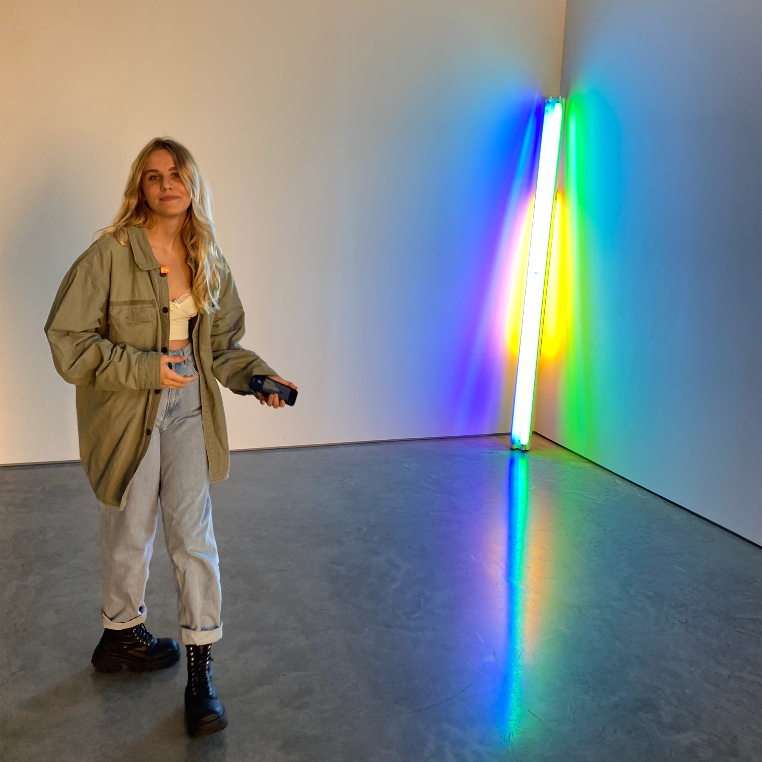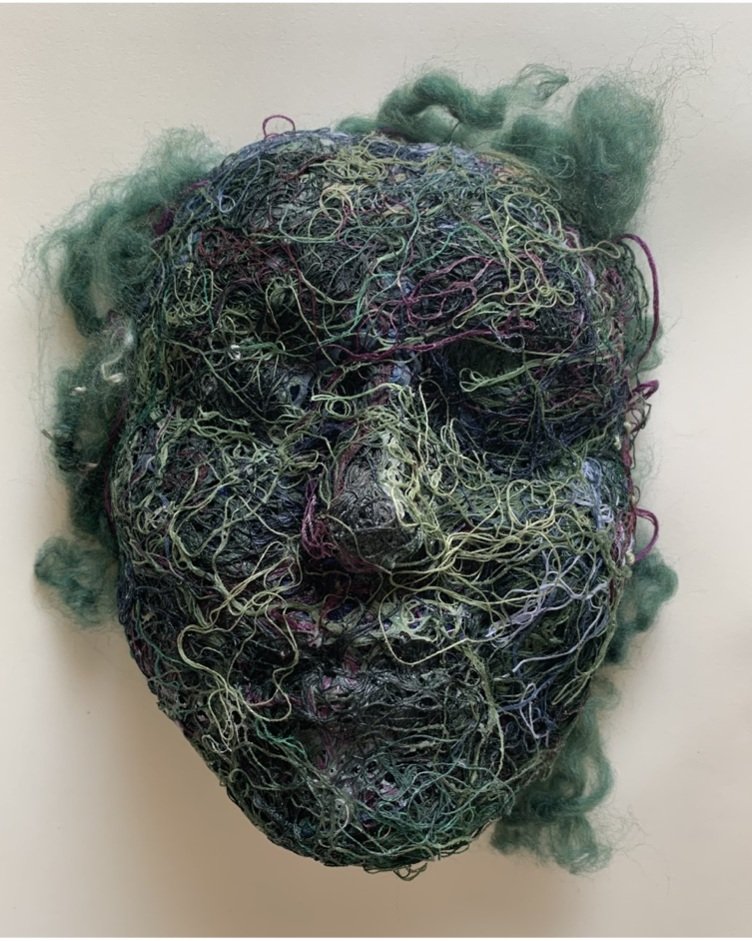november 8, 2022
Emma gregory: fine art, florals, and furbies
STORY BY Lorelei Horrell / EDITED BY olivia mckeon / Copyedited by Julia digeronimo
Emma Gregory (’23) is an artist with an associate degree in fine art. At Ithaca College, she’s continuing her studies with a minor in French, and she works as an art monitor in the Cerrache Center. Her favorite medium is oil paint, and she’s currently working on a senior thesis inspired by her time as a summer intern at the Munson-Williams-Proctor Arts Institute in Utica, NY.
Lorelei Horrell sat down with Emma Gregory in her studio in the Cerrache Center to discuss broadening her artistic focus beyond her personal experience, renewing historically popular art styles, and getting her face coated in plaster.
LH: How often are you here in your studio? What are you typically up to?
EG: I’m here pretty much every day just working. Fine art seniors get this studio space, and right now, there’s only two of us. This one half is mine and this half is another person’s. Basically, it’s an independent study. We work on this one body of work throughout the whole year, and then in the spring, it’ll be put up in the Handwerker Gallery. So usually when I’m here, I’m working on paintings or drawings. Or, because I work here, I might be cleaning or helping other kids with projects.
LH: How would you describe your art style?
EG: I do mostly oil painting. I dabble in some other things like drawing and printmaking. It’s definitely, at least recently, been a lot of—not abstract, but more like representational figure kind of work.
Over the summer, I was an intern at a museum in New York. They had a collection of Norman Rockwell’s work. It was very 50s, World War II era…just a lot of white, America-based things. When I was at the museum, a lot of people loved it because they remember it from their childhoods. But a lot of people really hated it because they were a whitewashed, very heteronormative kind of thing. I’m basing my senior project off that and trying to make those kinds of paintings more diverse.
LH: Who or what inspires you? Are there any recurring themes or patterns in your work?
EG: My family isn’t really…they’re not artists. My brother is a professional basketball player. It’s very, very different. But I’ve always liked art growing up, and it’s turned into an outlet for me. I would go to my brother’s games and just draw. There are so many contemporary artists that I love. Like I said, Norman Rockwell was like a huge inspiration when I was working this summer because I remember seeing his work growing up in history class.
In the past, a lot of my focus has been on personal identity. But I think this year, I’m trying to branch out beyond my singular experience to be more inclusive of other people as well, rooted in identity and perception of it.
LH: When you’re branching outside of your own identity, does that involve research of any kind?
EG: Definitely. I’ve been talking to a lot of my friends, and a lot of the faculty. I just had a professor in here looking at my work from the women’s, gender, and sexuality department, and she was helping me look at things. She also gave me a ton of articles and documentaries to watch. I’ve checked out way too many books from the library that I should probably return. It’s been so enjoyable.
LH: It sounds like your family isn’t super artistic. How did you get started with art, and how did it become important to you?
EG: My mom’s definitely a very crafty person. She crochets and does embroidery, and I think it started from there. She taught me how to cross stitch when I was a little kid, and I loved it so much. And I think it’s just something to do—on the sidelines when I was at my brother’s games I would sit and draw what was happening. I was a really shy kid, so I think drawing gave me an outlet to communicate in a different way.
LH: Your work “Violets” is the cover image of Stillwater 61. Could you tell me about that piece and what it was like making it?
EG: I made that painting last winter break. I knew I wanted to do some sort of fiber arts and some sort of painting. I always try to do a self-portrait every year just to see how my style changes over time. So, that was a self-portrait laying in grass, and I cross stitched the violets into it. Floral symbolism was something I was working with for a really long time, so that came into play. It was something over winter break to experiment with what my senior project could be.
LH: What do you like about oil painting?
EG: I was an acrylic painter for a really long time, and I loved it. But it seems like oil painting is an art-world standard. It’s so smooth. Also, I did do colored pencils for a while, but I love oil because you can mix colors, and it’s very versatile. You can paint on so many different surfaces.
LH: It also seems like you do a lot of physical body molds. What’s that like, and what draws you to it?
EG: I’ve only done one for myself. Last fall, I was taking a sculpture class, and I did my face. That was fun. They covered my whole face with plaster, except my nostrils so I could breathe. I made these wax replicas of my face with flowers in them. That piece [“Face”] was also in Stillwater.
All the other ones I’ve done were for friends that needed a person to cast. Last semester, I was a TA for intermediate and advanced sculpture. There was one girl that really wanted to do a face, but nobody would do it, so I did my face again for her. This semester, my friend needed somebody’s legs, so she did my legs. I did my face twice again last week.
Because they cover your whole face, some people get scared. You can’t see or talk. It’s just dark and cold. Some people get claustrophobic. There’s also a weird thing—if you have a certain nose, the plaster gets locked in, and the only way to get it off at that point is with a hammer, so you can end up getting very bruised. I think once they found out my face doesn’t bruise, they were like, we’ll keep you going.
LH: The subjects of your work can really vary. What’s your process like when you decide what to make? Do you usually have an end result in mind, or do you just work and see what happens?
EG: I think I usually go with an end result in mind, which has its benefits and has its setbacks. If it doesn’t come out how I envision it, I get frustrated.
Usually, I just see something, and I think it would look good in a painting. I have a little painting of a Furby on my Instagram. My brother had a Furby, and I thought it was a funny idea. I usually just find a reference or an idea and go from there, and I adapt whatever image I have in my head of it as it goes along.
LH: What are some of your favorite pieces you’ve made?
EG: I think the Furby painting is probably one of my favorites actually just because it was silly. People bring it up to me all the time, and I sold it in an exhibition last summer. I also did a print in a printmaking class last semester of a raccoon playing a guitar. I love the other work I’m doing, the more serious stuff, but I just think those little silly things are so fun and enjoyable to make.
LH: What do you think it is about the Furby that makes people bring it up to you all the time?
EG: In my family, we very much love 70s and 80s and 90s movies. Especially with an older generation that remembers having Furbies as kids, it just sends them back. And compared to the serious work I’m doing here, they might think, “But like, why are you painting a Furby?”
It was my brother’s Furby from when he was a kid, so it’s always been in our house. I think nostalgia plays a lot into it. Because again, like the Rockwell work, it’s very nostalgic America.
LH: You mentioned your more serious work in comparison to these more playful projects?
EG: So, for the thesis I’m working on, it’s still fun and playful to a certain extent. I’m not painting unhappy figures. They’re mostly couples having a good time.
When I worked over the summer at the museum, I heard so much debate between the museum staff and museum visitors about if Rockwell’s work should even be shown because of how specific it is to one demographic. But it was a huge part of history. “Does it still hold up today?” was something I would constantly hear. I’m trying to get away from that with my work now because I still love Rockwell’s paintings, and I know a lot of people that do, but it’d be nice to have something that represents myself and others more.







